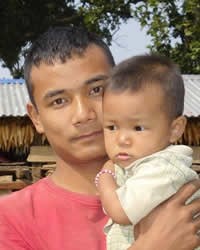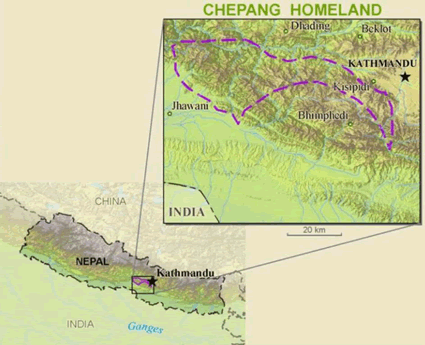Chepang, Tsepang in Nepal

Photo Source:
Copyrighted © 2025
Kerry Olson All rights reserved. Used with permission |

Map Source:
People Group data: Omid. Map geography: UNESCO / GMI. Map Design: Joshua Project
|
| People Name: | Chepang, Tsepang |
| Country: | Nepal |
| 10/40 Window: | Yes |
| Population: | 71,000 |
| World Population: | 72,500 |
| Primary Language: | Chepang |
| Primary Religion: | Hinduism |
| Christian Adherents: | 10.25 % |
| Evangelicals: | 0.00 % |
| Scripture: | New Testament |
| Ministry Resources: | Yes |
| Jesus Film: | No |
| Audio Recordings: | Yes |
| People Cluster: | South Asia Hindu - other |
| Affinity Bloc: | South Asian Peoples |
| Progress Level: |
|
Introduction / History
The Chepang are one of the more isolated tribal groups of Nepal and India. In Nepal, they live in the districts of Chitwan, Makwanpur, Dhading and Gorkha. The altitude of this region is between 4,000 to 6,500 feet above sea level, producing a cool and pleasant climate in the summer and a chilly climate in the winter. Destruction of the forests and the demands of an increased population have caused vast land erosion, threatening their environment and their unique culture.
The origin of the Chepang is unclear, but numerous legends tell of their relationship to Lav, son of the Hindu god, Rama. For over a thousand years, the Chepang lived in very poor conditions. In the 20th century, their quality of life began to improve due to the development of progressive agricultural techniques. Before they began to settle in villages, the Chepang led a nomadic life, doing some fishing and hunting.
What Are Their Lives Like?
Their habitat is suitable for raising livestock, but unfortunately, they do not possess enough practical knowledge to be successful. They primarily raise goats, cows, bulls, pigs and occasionally buffalo. For at least half of the year, they eat well as a result of their agricultural efforts. However, for the other half of the year, they exist on the products of the forests and remain suspended on the edge of starvation. Some Chepang hire themselves as laborers in various areas away from their villages.
The Chepang live as extended family units, often with three generations living in the same house. If a family has many sons, or if a son has many wives, the men will live separately with their wives and children. The family structure is patrilineal (line of descent traced through the males) and predominantly patriarchal (male-dominated), but the mother plays an important social role.
Most Chepang marriages are arranged though love marriages happen as well. They marry outside their clan. Weddings involve dance, music and rituals.
Women marry in their mid-teens and have as many children as possible. Often the children are malnourished and the mothers face health issues because they give birth so young. When a child is born, the mother is considered polluted; the household must observe cleansing rituals for eight days. On the ninth day, the child is given a name. Twenty-two days after birth, the mother is considered purified and is allowed to resume her participation in any social, religious or community gatherings.
When someone dies they hold a solemn ceremony with death rituals to ensure safe passage of the soul into the afterlife. There is a period of mourning.
What Are Their Beliefs?
The Chepang are primarily ethnic religionists. However, they have integrated many beliefs and practices from other religions into their unique system. They perform many rituals and worship a variety of deities. An important ritual the Chepang observe is known as the Kulain Puja, which involves the worship of dead ancestors.
There is a Christian minority, especially in Glakhok. Christian work is often centered around providing blankets, sweaters and other needs.
What Are Their Needs?
Though life has improved tremendously for the Chepang people in the last 40 years, they have many needs. Schools and hospitals are among their greatest needs. Literacy is below 20 percent and there is a high dropout rate in schools. They need to learn ways to produce enough food.
Prayer Points
Pray for skilled and loving workers to help the Chepang start a bee-keeping business and better yields for their farms.
Ask God to strengthen, encourage and protect the small number of Chepang Christian believers. Pray that Indian followers of Christ will be led to go to and help the Chepang. Ask the Lord to bring forth a strong Chepang church planting movement. Pray for a Holy Spirit-driven hunger for truth among Chepang family leaders.